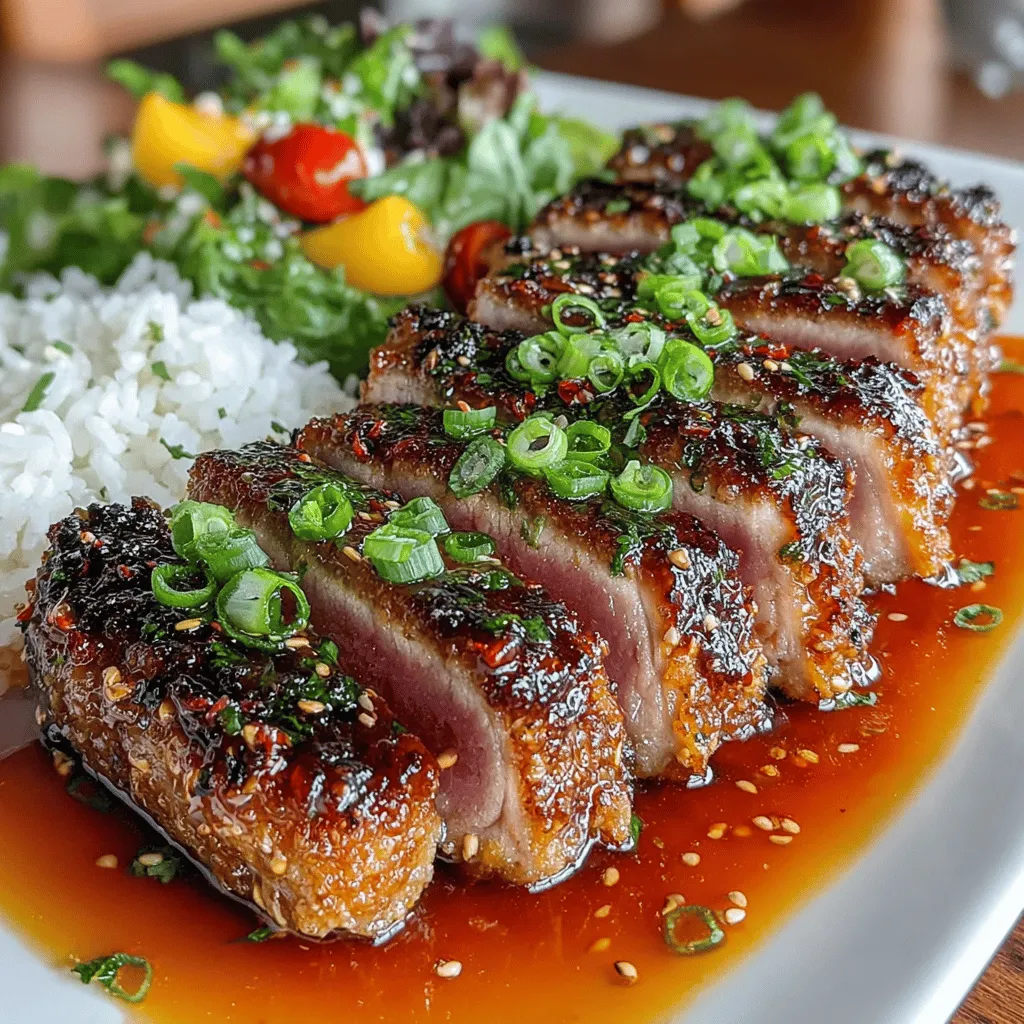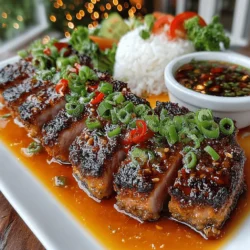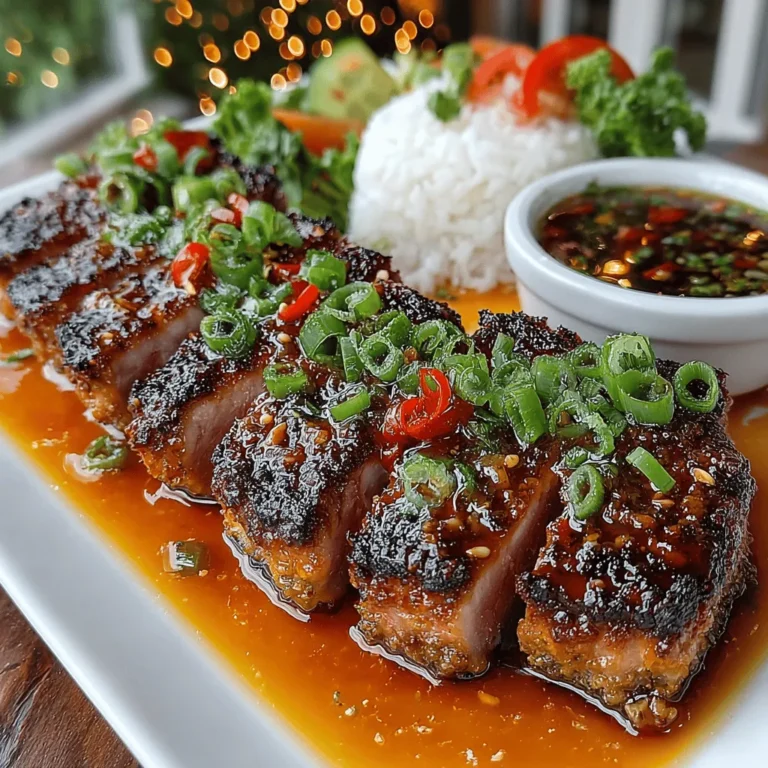Introduction
Mango Glazed Tuna is a dish that beautifully marries the rich, meaty texture of tuna with the vibrant sweetness of mango, creating a culinary experience that is both refreshing and indulgent. This recipe not only dazzles the palate but also offers an appealing visual presentation, making it an ideal choice for dinner parties or a simple weeknight meal. The fusion of flavors in the mango glaze elevates the tuna, transforming a straightforward protein into a gourmet delight.
One of the standout features of Mango Glazed Tuna is the glaze itself, which combines sweet, savory, and tangy elements into a harmonious blend. The result is a dish that tantalizes the taste buds while providing numerous health benefits. It’s quick to prepare, making it perfect for busy individuals or families looking for a nutritious meal without spending hours in the kitchen. In just a few simple steps, you can create a dish that is both impressive and satisfying.
Understanding Tuna
Tuna is a powerhouse of nutrition, known for its high protein content and numerous health benefits. As a lean source of protein, it is an excellent choice for those looking to maintain or build muscle while keeping calorie intake in check. Packed with essential nutrients, tuna is not just about protein; it also boasts a rich profile of vitamins and minerals, including Vitamin D, selenium, and B vitamins.
One of the most notable health benefits of tuna is its high concentration of omega-3 fatty acids, which are crucial for heart health and brain function. These healthy fats are known to reduce inflammation, lower blood pressure, and improve overall cardiovascular health. Incorporating tuna into your diet is a smart choice, particularly for individuals seeking to enhance their overall well-being.
There are several types of tuna, each with unique flavors and culinary uses. Some of the most popular include bluefin, yellowfin, and albacore. Bluefin tuna is often revered for its rich flavor and is commonly used in sushi and sashimi. Yellowfin, slightly milder, is versatile and can be grilled, seared, or used in salads. Albacore, known for its white flesh and mild taste, is often found in canned form and can be used in a variety of dishes, including sandwiches and salads. Understanding the different types of tuna can help you select the best option for your Mango Glazed Tuna recipe.
The Star Ingredient: Mango
Mango is often referred to as the “king of fruits,” and for good reason. This tropical fruit is not only delicious but also boasts an impressive nutritional profile. Rich in vitamins A, C, and E, mangoes are powerful antioxidants that contribute to skin health and immune function. They are also a good source of dietary fiber, which aids in digestion and promotes a healthy gut.
Beyond its nutritional benefits, mango adds a unique dimension to savory dishes, such as our Mango Glazed Tuna. The natural sweetness of mango pairs beautifully with the umami flavor of tuna, creating a delightful contrast that enhances the overall dish. The fruit’s juicy texture and vibrant color also make it an attractive addition, appealing to both the eyes and the palate.
Crafting the Perfect Mango Glaze
Creating the perfect mango glaze is key to achieving the desired balance of flavors in this dish. A well-crafted glaze will harmonize sweetness, savory notes, and a hint of tang, making the tuna truly shine. The ingredients used in the glaze play a significant role in achieving this balance.
– Soy Sauce: This ingredient adds depth and umami, enhancing the savory aspect of the glaze. The saltiness of soy sauce complements the sweetness of the mango, providing a rich flavor that elevates the dish.
– Honey: As a natural sweetener, honey contributes to the glaze’s sweetness while also providing a smooth texture. It helps to caramelize the glaze when cooked, creating a beautiful finish on the tuna.
– Rice Vinegar: A splash of rice vinegar introduces a tangy kick that cuts through the sweetness and adds complexity to the glaze. Its mild acidity balances the flavors, making the dish more dynamic.
– Ginger and Garlic: These aromatic ingredients bring warmth and depth to the glaze. Ginger adds a zesty note that complements the mango, while garlic contributes a savory undertone that ties all the elements together.
Initial Steps in Preparing Mango Glazed Tuna
To prepare Mango Glazed Tuna, begin by gathering all of your ingredients. You will need fresh tuna steaks, ripe mango, soy sauce, honey, rice vinegar, ginger, garlic, and a few optional garnishes such as sesame seeds and green onions for serving.
1. Prepare the Tuna: Start with high-quality fresh tuna steaks, ideally around 1-inch thick. Pat them dry with paper towels to remove excess moisture, which will help achieve a nice sear when cooking. Season the tuna lightly with salt and pepper to enhance its natural flavor.
2. Make the Mango Glaze: While the tuna is resting, prepare the glaze. Begin by peeling and dicing the ripe mango into small pieces. In a mixing bowl, combine the diced mango with soy sauce, honey, rice vinegar, minced ginger, and minced garlic. Use a fork or whisk to blend the ingredients until you have a smooth and cohesive glaze. Taste and adjust the sweetness or acidity as needed, depending on your preference.
3. Marinate the Tuna: Place the seasoned tuna steaks in a shallow dish or resealable plastic bag. Pour half of the mango glaze over the tuna, reserving the other half for basting and serving. Allow the tuna to marinate for at least 15-30 minutes at room temperature. This step infuses the fish with flavor and helps tenderize it.
By following these initial steps, you are setting the foundation for a delicious Mango Glazed Tuna dish that is not only easy to prepare but also packed with flavor and nutrition. In the next section, we will delve into the cooking process, providing tips for achieving the perfect sear and serving suggestions to elevate your meal further.

Sesame Oil: Bringing Richness to the Dish
Sesame oil is an essential component in the mango glazed tuna recipe, offering a warm, nutty flavor that complements the freshness of the fish and the sweetness of the mango glaze. This oil enhances the richness of the dish, making every bite an explosion of flavor. When using sesame oil, it’s important to choose high-quality, toasted sesame oil for its robust taste. A drizzle of sesame oil not only amplifies the dish’s depth but also adds a layer of authenticity to your culinary creation.
Step-by-Step Guide to Preparing the Mango Glaze
Creating the mango glaze is a straightforward process that transforms your tuna steaks into a culinary masterpiece. Follow these simple steps to prepare a glaze that is both flavorful and visually appealing.
Ingredients for Mango Glaze
– 1 ripe mango, peeled and diced
– 2 tablespoons honey or agave syrup
– 1 tablespoon soy sauce
– 1 tablespoon sesame oil
– 1 tablespoon lime juice
– 1 teaspoon grated ginger
– Pinch of salt
Instructions
1. Blend the Ingredients: In a blender or food processor, combine the diced mango, honey (or agave syrup), soy sauce, sesame oil, lime juice, grated ginger, and salt. Blend until smooth.
2. Adjust Consistency: If the glaze is too thick, add a teaspoon of water at a time until you reach the desired consistency. It should be pourable but thick enough to cling to the tuna.
3. Taste and Adjust: Taste the glaze and adjust the sweetness or acidity according to your preference. A bit more lime juice can brighten the flavor, while additional honey can enhance the sweetness.
4. Set Aside: Once blended, transfer the glaze to a bowl and set aside. It can be made a few hours in advance and stored in the refrigerator until you’re ready to use it.
Marinating Tuna Steaks
Importance of Marination for Flavor Enhancement
Marinating your tuna steaks is crucial for infusing them with flavor and moisture. The marination process allows the fish to absorb the seasoning, resulting in a more flavorful and juicy bite. The combination of the soy sauce and sesame oil in the glaze not only enhances the taste but also helps tenderize the fish.
Recommended Marination Time and Tips for Achieving the Best Results
For the best results, marinate your tuna steaks for at least 30 minutes, though an hour is ideal for deeper flavor penetration. Here are some tips:
– Use a Zip-top Bag: Place the tuna steaks in a zip-top bag with the mango glaze. This method ensures that the marinade evenly coats the fish.
– Refrigerate: Always marinate in the refrigerator to prevent any bacterial growth.
– Do Not Over-marinate: Tuna is a delicate fish. Marinating for too long can change its texture and make it mushy. Stick to the recommended time.
How Marination Affects the Texture and Taste of Tuna
Marination not only enhances the flavor but also modifies the texture of the tuna steak. The acids in the marinade (like lime juice) help break down proteins, resulting in a tender texture. The marinated tuna will have a pleasant balance of savory and sweet notes, perfectly complementing the natural richness of the fish.
Cooking Methods for Tuna
Comparison Between Grilling and Pan-Searing
Both grilling and pan-searing are excellent methods for cooking tuna, each offering unique benefits.
– Grilling: Cooking tuna on a grill imparts a smoky flavor and beautiful char marks. This method is ideal if you enjoy a slightly crisp exterior while keeping the inside tender and juicy.
– Pan-Searing: This method allows for better control over cooking temperatures and times, making it easier to achieve your desired level of doneness. It is also convenient if you don’t have access to an outdoor grill.
Tips for Achieving the Perfect Sear on Tuna Steaks
Regardless of the cooking method you choose, here are some tips for achieving the perfect sear:
1. Preheat Your Cooking Surface: Whether using a grill or a skillet, ensure it is hot before adding the tuna. A hot surface will create a beautiful crust while locking in moisture.
2. Oil the Surface: Lightly oil the grill grates or the skillet with a high smoke-point oil to prevent sticking.
3. Do Not Overcrowd: If you’re cooking multiple steaks, ensure there is enough space between them. Overcrowding will lower the temperature and result in steaming rather than searing.
Cooking Times for Different Levels of Doneness (Medium-Rare vs. Medium)
Tuna is best served medium-rare, where the center remains pink and slightly warm. Here’s a guideline for cooking times:
– Medium-Rare: Cook for 1.5 to 2 minutes per side. The internal temperature should reach about 120°F (49°C).
– Medium: Cook for 2 to 3 minutes per side. The internal temperature should reach about 130°F (54°C).
Keep in mind that tuna continues to cook slightly after being removed from heat, so it’s wise to take it off just before reaching your desired doneness.
Presentation and Serving Suggestions
Creative Ways to Plate the Mango Glazed Tuna
Presentation is key to enhancing the dining experience. Here are some creative plating ideas:
– Layered Presentation: Serve the tuna steaks atop a bed of jasmine or basmati rice, drizzling the mango glaze over the top. Add a sprinkle of sesame seeds and chopped green onions for added texture.
– Tuna Tacos: For a playful twist, slice the cooked tuna into strips and serve in soft corn tortillas. Top with mango salsa and a drizzle of the glaze for a fresh taco option.
Complementary Side Dishes
To elevate your meal, consider pairing the mango glazed tuna with complementary side dishes:
– Steamed Rice Options: Jasmine rice or coconut rice pairs beautifully with the tuna, absorbing the flavors of the mango glaze while adding a fragrant backdrop.
– Fresh Salad Pairings: A crisp salad featuring mixed greens, cucumber, and avocado dressed with a light vinaigrette can provide a refreshing contrast to the rich tuna.
Garnishing Tips for Visual Appeal
A well-garnished dish can take your meal to the next level. Here are some garnishing tips:
– Herbs: Fresh cilantro or basil can add a burst of color and freshness. Scatter leaves over the top just before serving.
– Lime Wedges: Serve with lime wedges on the side for an extra zesty kick that diners can squeeze over the tuna.
– Microgreens: Use microgreens for an elegant touch. Their delicate texture and vibrant colors enhance both the visual appeal and flavor.
Conclusion
The mango glazed tuna recipe combines unique flavors and health benefits, making it a dish worth trying. The tropical sweetness of the mango glaze harmonizes beautifully with the savory notes of the marinated tuna, creating a delightful dining experience. This recipe is not only easy to prepare but also versatile enough for various occasions, from casual weeknight dinners to elegant gatherings.
Encourage your culinary creativity by experimenting with different cooking methods and side dishes. Whether you choose to grill or pan-sear, the resulting dish will surely impress your family and friends. Enjoy the process, and savor the delicious results of your hard work.


